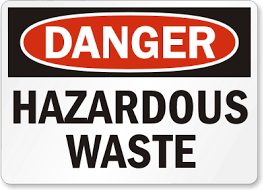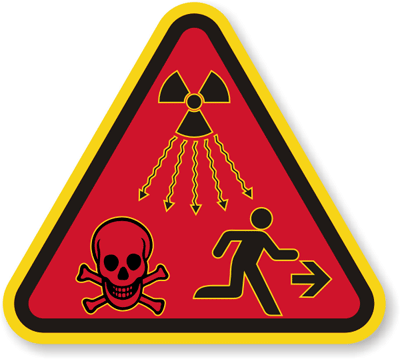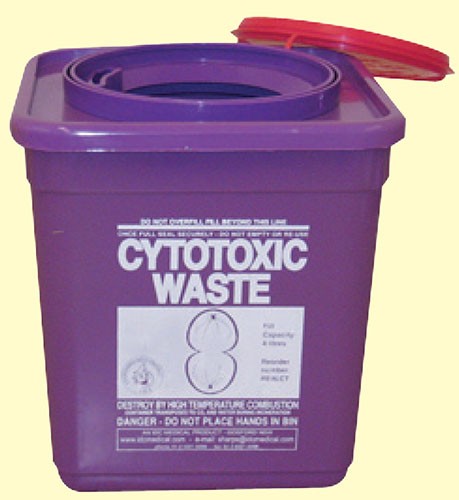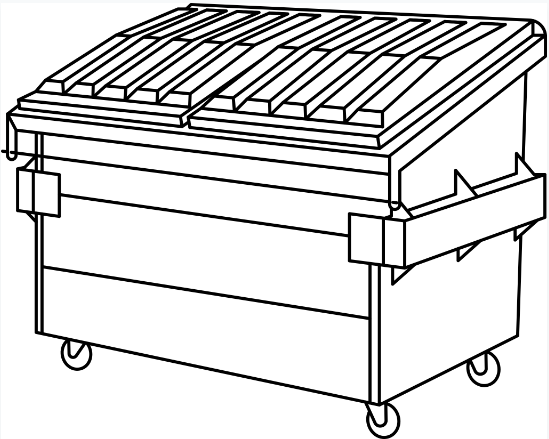These labels are warnings to employees and the public about the type of waste in the container. Your local jurisdiction may have rules about warning labels that must be affixed to storage containers. Even if there are no legal requirements, best practices call for warnings that indicate the nature of the hazard. For infectious, pathological, and most regulated medical waste, the medical waste symbol can be employed.  If you buy bags and containers designed for medical waste, these often come with the medical waste symbol on it.
If you buy bags and containers designed for medical waste, these often come with the medical waste symbol on it.
The hazardous waste symbol, although not as widely recognized as the medical waste symbol, is appropriate for RCRA waste. 
Radioactive waste (often produced in healthcare facilities) and mixed waste (mix of radioactive and hazardous waste) should be labeled with the universal radiation symbol. 
Some countries require designation of cytotoxic drug waste. Here’s a container sold in Australia for such waste. https://www.seton.net.au/cytotoxic-waste-containers-a40239.html 
Well-managed operations require their employees to put labels on waste bags and containers for tracking purposes. It is not different from an inventory management system. Employees (either those who generate the waste or waste technicians) should apply a label with the date, type of waste, and point of generation. Doctors, dental, and veterinary offices are usually small enough to not do this, but any hospital should. The weight of the waste should be recorded. This information will be useful in the long run for identifying problems in cross-contamination among waste streams and mistakes in segregation.
OSHA has requirements for worker safety when it comes to blood and “other potentially infectious material”. These include labeling of storage containers with the biohazard symbol, and the term "biohazard." The background of the label must be fluorescent orange or orange-red. OSHA does allow facilities to use red bags instead of biohazard labels.
I’m afraid my customers will be scared off if they see a sign saying “medical waste”.
The point of the sign is to alert people to a possible hazard. So it should be a little scary. It doesn’t have to scare customers away if you keep the waste in locations where customers do not normally go.
The marketplace is full of vendors that sell bags for medical waste. Just look in a directory of industrial supplies or an internet search. For the most part there are no (or few) government regulations on these (containers for sharps are another matter.) The vendors may brag their bags are thick and resist punctures. Some bags are labeled with the biohazard symbol and some are colored. Some manufacturers sell both the sturdy containers (specifically labeled for medical waste) and the plastic (or canvas) bag that goes with it. Many manufacturers make medical waste bags red, and some waste management plans insist that their customers use red bags. You might hear of “red bag waste”. You might think this designation has a legal meaning, but it doesn’t. There is no rule that says your infectious or pathological waste must be put in a red bag, although most industrial hygienists and sanitation engineers probably prefer a red bag, all other things being equal.
The best practice for most facilities is to buy these dedicated medical waste bags. Could you just use general purpose garbage bags? In a pinch you could and these will work for most medical waste items, provided you don’t overfill them. But in general you want to keep medical waste in containers labeled medical waste, and it is worth paying a little more to get bags and bins already labeled.
Bags sold for medical waste are usually made from linear low-density polyethylene, although some may be made from polypropylene. High-density polyethylene is also used. One good thing about these materials is that they will burn in an incinerator with almost no ash. Bagged waste does not need to be removed from the bag before it enters the furnace. Some processes move the bags through a shredder first, which breaks the bags and may mix the waste from one bag with another.
The State of Florida requires that infectious waste be stored on site in red bags, and they even have a list of approved vendors of those bags.
Waste bags should be filled to no more than three quarters full. At that point they should be closed for collection. Don’t staple the bag closed. Either use a twisty, or, if the bag comes ready to self-seal, employ that. Keep spare bags in areas where waste is collected in bags, so employees are not tempted to overfill any one bag.
Bags come in sizes from sandwich size to as big as 55-gal drums (a standard drum size in industry.) The World Health Organization recommends infectious waste bags be a minimum of 70 µm in thickness (ISO 7765 2004). It is easy to find bags thicker than that.
One disadvantage of bags shows up when autoclave treatment is used. To ensure the waste is heated adequately, the bags must be opened to allow the steam in. When bagged waste is to be incinerated, this is not a concern, as the bags themselves are combustible. However, some plastic bags may melt in the autoclave, producing a mess. To avoid this, test bags in the autoclave with no waste. Bag suppliers might be able to specify a temperature the plastic will stand up to.
Double-bagging - putting one bag inside another - is a method to reduce the chances of leaks. It is used in many waste handling situations. Consider using it if the contents of the bag could pierce the plastic or if the waste is of a concern that an extra safety measure is called for.
More sturdy containers are employed to hold large quantities of waste. You can buy these from many retailers and there are no "official" requirements for them. If a legal dispute arises, the court will look at whether the waste manager exercised due care. An important consideration in choosing a container is the expected nature of the waste and whether it is a dry solid, a liquid, a slurry, or a wet solid. Containers, bins, barrels for medical waste can be made from various materials (plastic, mild steel, stainless steel). The term IBC (intermediate bulk container) refers to containers with capacities between 70 gallons and 700 gallons, which are approved by the Department of Transportation for handling of hazardous and non-hazardous materials. These are often configured for easy transport by forklift. Many people keep the IBCs on pallets during us. IBCs are difficult to clean without removing them, so if cleaning is needed, a differemt type of tank may be required. Colors should conform with whatever scheme you have set for your facility.
Large containers should be lockable, especially if they are going to be outdoors or in an area where a lot of customers or non-professionals frequent.
An interesting idea is the development of refigerated containers for short-term storage of biological waste. These would be about the size of a standard trash can and employees would deposit the waste in them immediately upon generation. No such units have hit the market yet, as far as we know.
One mistake facility managers make is assuming that the container a material was delivered in when it is purchased is acceptable as a waste container for the same material. Once the material becomes a waste, it is subject to different labeling rules and regulations and if the material has changed, the old container might not be tight enough. The in-bound shipping container might not suffice as a storage or out-bound shipping container.
If you have a waste removal service, they might be able to provide containers. Considering the low cost of the containers compared to what they charge, they really should do so if they want you as a regular customer. They may also have containers that fit with their hand trucks or other mechanical transport means.
In answer to a question about blood/body fluids, OSHA’s website says: "regulated wastes, other than contaminated sharps, must be placed in containers which are: (i) Closable; (ii) Constructed to contain all contents and prevent leakage of fluids during handling, storage, transport or shipping; (iii) Labeled or color-coded in accordance with paragraphs (g)(1)(i); (iv) Closed prior to removal to prevent spillage or protrusion of contents during handling, storage, transport, or shipping [29 CFR 1910.1030(d)(4)(iii)(B)(1)(i)-(iv)]."
You don’t want to put regulated waste in dumpsters, which are not built tight enough to keep out rain and vermin. Outdoor dumpsters are okay for municipal solid waste, but regulated waste (hazardous, radioactive, biological) should be kept in tight containers and indoors.

These containers are designed to prevent people from being hurt by needles, scalpels, and lancets. Sharps containers are generally made of thick plastic, and have a door that opens so the user can insert the sharp into the container. When the door is closed, the sharp is dropped down into the main chamber of the container. The container functions much like a standard post office mailbox, in that the user cannot reach the sharps inside the container via the door.
Sharps containers are found in hospitals, clinics, medical practices, and can also be used by private individuals who use sharps in the home, such as diabetics who require regular injections of insulin. Home users can buy sharps containers at stores or online. Many home users employ a private disposal company and some of those provide sharps containers. When the individual fills the container, the container is then mailed to the disposal company for disinfection and destruction prior to disposal.
Storage rooms should have locks and be away from the public and most building occupants. Ideally they should be indoors, but any outdoor storage should be fenced to keep away animals and humans.
State regulations often dictate the maximum amount of time that medical waste can be stored prior to treatment. For example, in the state of New York, storage of regulated medical waste is limited to seven days. Medical waste must be stored separately from municipal solid waste. All reusable storage containers must be disinfected after they have been emptied, unless they employ a disposable liner that is removed with the waste.
Workplace safety rules apply to medical facilities, and waste managers must worry about employee safety.
The International Committee of the Red Cross (ICRC) recommends storage time for infectious waste not exceed 72 hours in winter and 48 hours in summer in temperature climate zones. In hot climates, the recommended limits are 48 hours in the cooler season and 24 hours in the warmer season. If refrigerated storage is available, hold times can go up to a week, per the ICRC, if the temperature is between 3 °C and 8 °C.
The ICRC recommends criteria for storage areas. While this does not have the force of law, they are good guidelines and should help you with regulators:
ICRC publication on medical waste.
You might hear the words containment and confinement used when describing storage areas. For all practical purposes they mean the same thing when it comes to design of storage facilities for medical waste. A frequent design paradigm calls for "secondary containment" - often a berm around the containers - to prevent material that accidently escapes from the container from spreading.
The patent literature describes many disposal containers for medical waste. These are actually storage containers for temporary isolation of the waste from human workers. (Disposal refers to a long-term and presumably permanent resting place for waste.) Storage is of concern to the waste manager, too, and vendors provide a wide variety of options for containers. Your state government still might have something to say about storage but the containers on the market usually are acceptable to them.
Operating procedures for your business should specify the maximum time you intend to store waste on site. If you know how fast your waste is generated and how often it gets taken off-site you will be able to determine the volume and type of storage needed.
Large operations often have small collection bins spread around the facility. For instance, a complex of doctors’ offices may have containers in each examination room, with a regular schedule of transferring this waste to a larger storage unit.
The placement of the storage units is an element in the overall design of the waste management process. Factors that must be weighed:
Transportation of medical waste.
